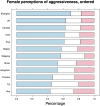Human preferences for sexually dimorphic faces may be evolutionarily novel
- PMID: 25246593
- PMCID: PMC4210032
- DOI: 10.1073/pnas.1409643111
Human preferences for sexually dimorphic faces may be evolutionarily novel
Abstract
A large literature proposes that preferences for exaggerated sex typicality in human faces (masculinity/femininity) reflect a long evolutionary history of sexual and social selection. This proposal implies that dimorphism was important to judgments of attractiveness and personality in ancestral environments. It is difficult to evaluate, however, because most available data come from large-scale, industrialized, urban populations. Here, we report the results for 12 populations with very diverse levels of economic development. Surprisingly, preferences for exaggerated sex-specific traits are only found in the novel, highly developed environments. Similarly, perceptions that masculine males look aggressive increase strongly with development and, specifically, urbanization. These data challenge the hypothesis that facial dimorphism was an important ancestral signal of heritable mate value. One possibility is that highly developed environments provide novel opportunities to discern relationships between facial traits and behavior by exposing individuals to large numbers of unfamiliar faces, revealing patterns too subtle to detect with smaller samples.
Keywords: aggression; cross-cultural; evolution; facial attractiveness; stereotyping.
Conflict of interest statement
The authors declare no conflict of interest.
Figures





References
-
- Ryan MJ, Keddy-Hector A. Directional patterns of female mate choice and the role of sensory biases. Am Nat. 1992;139(S1):S4–S35.
-
- Folstad I, Karter AJ. Parasites, bright males, and the immunocompetence handicap. Am Nat. 1992;139(3):603–622.
-
- Johnstone RA. Sexual selection, honest advertisement and the handicap principle: Reviewing the evidence. Biol Rev Camb Philos Soc. 1995;70(1):1–65. - PubMed
-
- Perrett DI, et al. Effects of sexual dimorphism on facial attractiveness. Nature. 1998;394(6696):884–887. - PubMed
-
- Johnston VS. Female facial beauty: The fertility hypothesis. Pragmatics & Cognition. 2000;8(1):107–122.
Publication types
MeSH terms
LinkOut - more resources
Full Text Sources
Other Literature Sources

